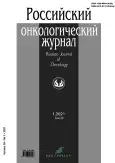Clinical prognostic factors for fibrolamellar liver carcinoma
- Authors: Antonova E.Y.1, Moroz E.A1, Podlyzny D.V.1, Kudashkin N.E.1, Volkov A.Y.2, Dzhanyan I.A.1, Laktionov K.K.1,3, Breder V.V.1
-
Affiliations:
- Blokhin National Medical Research Center of Oncology
- Pletnev City Clinical Hospital
- Pirogov Russian National Research Medical University
- Issue: Vol 26, No 1 (2021)
- Pages: 13-22
- Section: Original Study Articles
- Submitted: 23.01.2022
- Accepted: 24.02.2022
- Published: 15.01.2021
- URL: https://rjonco.com/1028-9984/article/view/97173
- DOI: https://doi.org/10.17816/1028-9984-2021-26-1-13-22
- ID: 97173
Cite item
Abstract
BACKGROUND: Fibrolamellar liver carcinoma is a rare subtype of liver cancer with an unexplored etiology. There is no information about the choice of classification for fibrolamellar liver carcinoma (FLC) in the world literature, and data on the prognostic significance of clinical aspects in FLC are very contradictory and require further study.
AIM: To evaluate the practical significance of staging systems for operable hepatocellular cancer for fibrolamellar carcinoma (TNM/AJCC, BCLC) as a separate option, to study the influence of clinical aspects (disease stage, gender, age, size of tumor) of patients with FlC on the long-term results of their treatment.
MATERIALS AND METHODS: The retrospective study included 34 patients with FlC who underwent radical surgical treatment at the first stage at the Blokhin National Research Institute of Oncology of the Ministry of Health of the Russian Federation from 2005 to 2020.
RESULTS: When assessing the prevalence of the disease according to the TNM-8/AJCC system, a significant correlation between the FlC stage and the prognosis was revealed. It is proved that the greatest RFS was achieved in the group of stages II–IIIB, while the smallest RFS was achieved in the group with stage IVB (p=0.002; p=0.000). The highest OS was achieved in the group of stages II–IIIB, while the lowest OS was achieved in the group with stage IVB (p=0.050; p=0.000). The OV of patients with FlC was not dependent
CONCLUSIONS: The TNM-8/AJCC classification optimally predicts the results of surgical treatment of FlC. The use of the Barcelona staging system for this subtype of liver cancer is impractical. The size of the primary tumor, as part of the FlC staging system, turned out to be an independent prognostic factor. The age of the patient ≥20 years correlates with the deterioration of OV.
Keywords
Full Text
About the authors
Elena Yu. Antonova
Blokhin National Medical Research Center of Oncology
Author for correspondence.
Email: elenaantonova5@mail.ru
ORCID iD: 0000-0002-9740-3839
SPIN-code: 6335-7053
PhD student of the Department of Medicinal Treatment (Chemotherapy № 17 Department)
Russian Federation, 24, Kashirskoe Shosse, Moscow, 115478Ekaterina A Moroz
Blokhin National Medical Research Center of Oncology
Email: moroz-kate@yandex.ru
ORCID iD: 0000-0002-6775-3678
MD, Cand. Sci. (Med.)
Russian Federation, 24, Kashirskoe Shosse, Moscow, 115478Daniil V. Podlyzny
Blokhin National Medical Research Center of Oncology
Email: dr.podluzhny@mail.ru
ORCID iD: 0000-0001-7375-3378
MD, Cand. Sci. (Med.)
Russian Federation, 24, Kashirskoe Shosse, Moscow, 115478Nikolai E. Kudashkin
Blokhin National Medical Research Center of Oncology
Email: dr.kudashkin@mail.ru
ORCID iD: 0000-0003-0504-585X
MD, Cand. Sci. (Med.)
Russian Federation, 24, Kashirskoe Shosse, Moscow, 115478Aleksandr Yu. Volkov
Pletnev City Clinical Hospital
Email: 79164577128@yandex.ru
ORCID iD: 0000-0003-4412-2256
SPIN-code: 3013-4392
MD, Cand. Sci. (Med.)
Russian Federation, MoscowIrina A. Dzhanyan
Blokhin National Medical Research Center of Oncology
Email: i-dzhanyan@mail.ru
ORCID iD: 0000-0002-6323-511X
SPIN-code: 5693-4504
Surgeon, Department of Medicinal Treatment (Chemotherapy No.17 Department)
Russian Federation, 24, Kashirskoe Shosse, Moscow, 115478Konstantin K. Laktionov
Blokhin National Medical Research Center of Oncology; Pirogov Russian National Research Medical University
Email: lkoskos@mail.ru
ORCID iD: 0000-0003-4469-502X
SPIN-code: 7404-5133
MD, Dr. Sci. (Med.), Prof.
Russian Federation, 24, Kashirskoe Shosse, Moscow, 115478; MoscowValery V. Breder
Blokhin National Medical Research Center of Oncology
Email: vbreder@yandex.ru
ORCID iD: 0000-0002-6244-4294
SPIN-code: 9846-4360
MD, Dr. Sci. (Med.)
Russian Federation, 24, Kashirskoe Shosse, Moscow, 115478References
- Edmondson HA. Differential diagnosis of tumors and tumor-like lesions of liver in infancy and childhood. AMA J Dis Child. 1956;91(2):168–186. doi: 10.1001/archpedi.1956.02060020170015
- Darcy DG, Malek MM, Kobos R, et al. Prognostic factors in fibrolamellar hepatocellular carcinoma in young people. J Pediatr Surg. 2015;50(1):153–156. doi: 10.1016/j.jpedsurg.2014.10.039
- Mavros MN, Mayo SC, Hyder O, Pawlik TM. A systematic review: treatment and prognosis of patients with fibrolamellar hepatocellular carcinoma. J Am Coll Surg. 2012;215(6):820–830. doi: 10.1016/j.jamcollsurg.2012.08.001
- Pinna AD, Iwatsuki S, Lee RG, et al. Treatment of fibrolamellar hepatoma with subtotal hepatectomy or transplantation. Hepatology. 1997;26(4):877–883. doi: 10.1002/hep.510260412
- El-Serag HB, Davila JA. Is fibrolamellar carcinoma different from hepatocellular carcinoma? A US population-based study. Hepatology. 2004;39(3):798–803. doi: 10.1002/hep.20096
- Hemming AW, Langer B, Sheiner P, et al. Aggressive surgical management of fibrolamellar hepatocellular carcinoma. J Gastrointest Surg. 1997;1(4):342–346. doi: 10.1016/s1091-255x(97)80055-8
- Smith M, Tomboc PJ, Markovich B. Fibrolamellar Hepatocellular Carcinoma. In: StatPearls. Treasure Island (FL): StatPearls Publishing; 2022.
- Stipa F, Yoon SS, Liau KH, et al. Outcome of patients with fibrolamellar hepatocellular carcinoma. Cancer. 2006;106(6):1331–1338. doi: 10.1002/cncr.21703
- Ang CS, Kelley RK, Choti MA, et al. Clinicopathologic characteristics and survival outcomes of patients with fibrolamellar carcinoma: data from the fibrolamellar carcinoma consortium. Gastrointest Cancer Res. 2013;6(1):3–9. PMC3597938
- Honeyman JN, Simon EP, Robine N, et al. Detection of a recurrent DNAJB1-PRKACA chimeric transcript in fibrolamellar hepatocellular carcinoma. Science. 2014;343(6174):1010–1014. doi: 10.1126/science.1249484
- Graham RP, Jin L, Knutson DL, et al. DNAJB1-PRKACA is specific for fibrolamellar carcinoma. Mod Pathol. 2015;28(6):822–829. doi: 10.1038/modpathol.2015.4
- Hemming AW, Langer B, Sheiner P, et al. Aggressive surgical management of fibrolamellar hepatocellular carcinoma. J Gastrointest Surg. 1997;1(4):342-346. doi: 10.1016/s1091-255x(97)80055-8
- Torbenson M. Fibrolamellar carcinoma: 2012 update. Scientifica (Cairo). 2012;2012:743790. doi: 10.6064/2012/743790
- Dinh TA, Vitucci EC, Wauthier E, et al. Comprehensive analysis of The Cancer Genome Atlas reveals a unique gene and non-coding RNA signature of fibrolamellar carcinoma. Sci Rep. 2017;7:44653. doi: 10.1038/srep44653
Supplementary files












